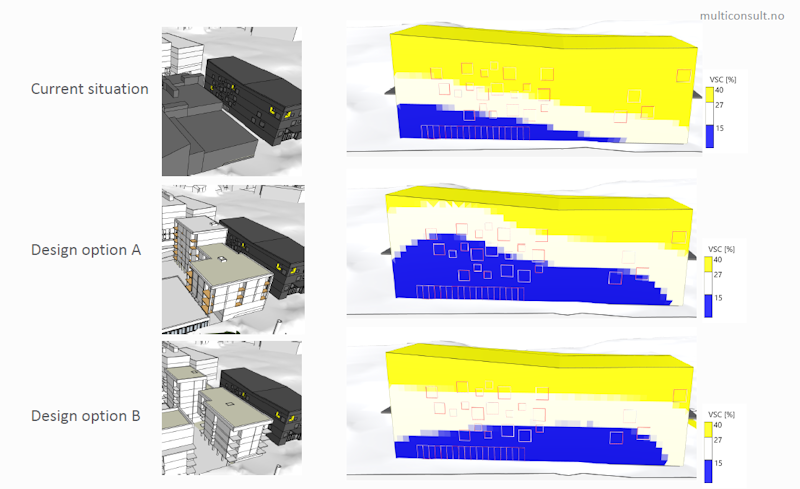Posted: March 24, 2023

Graphic: Multiconsult
How can urban planners secure the right to light and the right to solar access when densifying urban areas? Experts from Norway and Sweden discussed the challenges using various examples during the international seminar Solar and daylight planning in urban environments on 10 March 2023. Both countries lack requirements regarding solar access in their legislation. The IEA SHC Task 63 – Solar Neighborhood Planning organised the hybrid event, gathering participants in the Norwegian town of Trondheim. Figure 1 above shows the impact on the lighting situation of a building when increasing the number of floors in a neighbouring building.
Ida Bryn from the Norwegian consultancy Multiconsult talked about a case in Oslo which shows clearly that new legislation is necessary to protect building owners rights to light and solar.
Her story started in 2016 when a building owner wanted to raise their building by six floors with significant impact on a neighbouring house as you can see in the graphic above. The planning department of the city turned down the planning application. “The politicians, on the other hand, said they wanted this project to be realised because it increased the building density in the city and that is environmentally correct”, said Bryn. But the owner of the affected building took legal assistance and asked Multiconsult for technical support.
The consultancy calculated the daylight situation in the existing setting (on the left in figure 1), which shows that the façade had enough daylight according to the regulations (light-green areas). The middle image illustrates the strong reduction of daylight to only two floors if all six floors were built. “We proposed the compromise on the right-hand side that would have allowed the neighbour to build the six floors but with a sloping roof,” explains Bryn. The lawyers discussed the case for several years and finally the investor gave up at the end of 2022.
Regulations on legal access to daylight to avoid court cases
Her colleague Tobias Kristiansen stressed the fact that in some first cases in the United Kingdom, planning permission has been successfully overturned in court because the new construction blocked sunlight falling on a neighbour’s solar system. Both Multiconsult advisers agree that a lot of money that was spent on lawyers and technical consultancy could have been saved if there had been clear legal requirements.

Figure 2: Case study from Nye Broverkstedet in Norway. The tool Rhino with Ladybug was used to examine how the design of a new block (white/dark grey) would affect the lighting situation in the existing building (black).
Graphic: Multiconsult
Kristiansen talked about simulation results that show the impact of the design of neighbouring buildings on daylight accessibility. Figure 2 shows the existing situation at the top together with two alternative options: a seven-storey block building and a design with retracted facades. “In such studies we can give an indication on the impact of new-built structures without needing to know anything about the interior of the new neighbouring building, for which it is usually difficult to get access to data,” explained Kristiansen.
Active solar energy production has the lowest priority within urban planning
Jouri Kanters, Associate Professor at Lund University, Sweden, highlighted the important role that urban planners have in Sweden, as they have the full planning monopoly. “They are the only ones that could design a zoning plan that sets the density of neighbourhoods, building footprints and heights, roof inclinations for new building, etc.” But as the Swedish building code only regulates indoor daylight, but not direct solar access yet, urban planners usually prioritise indoor daylight compliance. The second important issue is the access to the direct sun on outdoor areas like playgrounds, city squares or outdoor seating.
“The urban planners also confirmed that guaranteeing an active solar energy production has the lowest priority within the urban planning phase. So they feel a bit disconnected from this part”, explained Kanters. And they also do not necessarily have the competence or the right tools to actually assess solar access. This is particularly true for towns and smaller municipalities. These are all results from a survey carried out by Kanters and his team among urban planners.

Figure 3: Analysis of suitable roof and façade areas to be used for active solar energy production in the neighbourhood of Hyllie in Malmö, Sweden. The analysis was performed with the tools Rhino and ClimateStudio.
Graphics: Lund University
Kanters used the new neighbourhood Hyllie in the Swedish city of Malmö to explain how his university supported the urban planners in maximising locally produced solar energy. “We identified all suitable roof and façade areas in the 3D model of the town and calculated roughly how much of the electricity consumed in the buildings would potentially be covered by solar electricity harvested in the coloured areas”, explained Kanters. The orange and red colour in figure 3 (right) indicate those areas that receive annual irradiation above a defined threshold. “We assessed that it would be possible to meet roughly 75 % of the plug load and a part of the space heating by placing PV panels on the coloured surfaces”, said Kanters. Next to that, the zoning plan also allowed PV panels to be added beyond the set maximum heights of the buildings.
This active solar energy potential was only one aspect of the analyses performed by Lund University - with others being direct solar access indoors and outdoors.
Obviously, the analysis cannot be very advanced, added Kanters, since many details of the buildings are unknown, but he found that the most important part was the discussion about the results of the analysis with the urban planners. As long as the urban planners were not satisfied, the researchers could run different loops within their tools, with the aim of trying to improve the zoning plan. Once the planners felt that the zoning plans achieved a satisfactory level for integrating solar energy, they went on with their planning.
Websites of organisations mentioned in this news article: